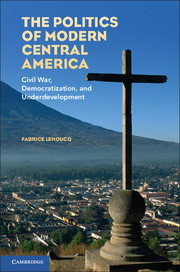Book contents
- Frontmatter
- Contents
- Figures
- Tables
- Introduction
- 1 Central America on the Eve of the 1980s
- 2 Civil War, Revolution, and Economic Collapse
- 3 Stalemates, Peace Negotiations, and Democratization
- 4 Economic Stability, Lackluster Growth, and Social Change
- 5 Democratization, State Capacity, and Redistribution
- Conclusion
- Bibliography
- Index
1 - Central America on the Eve of the 1980s
Published online by Cambridge University Press: 05 September 2012
- Frontmatter
- Contents
- Figures
- Tables
- Introduction
- 1 Central America on the Eve of the 1980s
- 2 Civil War, Revolution, and Economic Collapse
- 3 Stalemates, Peace Negotiations, and Democratization
- 4 Economic Stability, Lackluster Growth, and Social Change
- 5 Democratization, State Capacity, and Redistribution
- Conclusion
- Bibliography
- Index
Summary
Introduction
The six economies of Central America, sandwiched between Mexico and South America (Hall and Pérez-Brignoli, 2003), are prototypical of the smaller economies of the developing world. Each depends on the export of agricultural commodities, which generates the foreign exchange necessary for development. The price of coffee and bananas, the region’s dominant exports during the twentieth century, remained subject to the whims of international supply and demand, because both crops are grown throughout the tropics (Bates, 1997). This production feature, which made these economies price-takers in global markets, had profound effects on Central American societies, ones that would shape relations between landlords and peasants, the nature of their states, and their economic and social well-being.
Inequality in land distribution, coupled with demands of the international market for coffee and bananas, led to a predictable social structure. The spectacular returns of export agriculture enriched landowners, coffee processors, and banana producers. Most of the population, which remained predominately rural until the 1970s, either grew crops for domestic consumption or worked for wages on large estates. For many observers, dictatorship was inevitable in Central America, for only military despots could ensure the conditions needed for the docile labor force required to plant and harvest coffee and pick bananas.
- Type
- Chapter
- Information
- The Politics of Modern Central AmericaCivil War, Democratization, and Underdevelopment, pp. 11 - 29Publisher: Cambridge University PressPrint publication year: 2012

